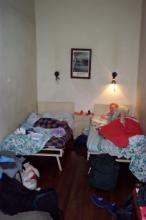

2-Jan-2003 - The trip is underway. Right now, it is just after 5 PM and I am on route from Boston to Miami, where I will be catching a flight to La Paz, Bolivia. This trip is different fom my other trips in some interesting ways. Firstly, this will be my first time in a third world country. I had to do much more preparation than I have done for anywhere else, such as vaccinations for typhoid and hepatitis. Secondly, I have never been to Latin America, not even Mexico (which tends to surprise many people). Bolivia is an unusual first destination for people in my category. It is one of the poorest nations in the hemisphere. Parallels with Tibet come to mind; both are on monsterous plateaux and are very remote. La Paz is 3400 meters above sea level. We plan to take it very easy when we link up tomorrow.
Pradip has been in South America for over a week now; last I heard he was in Arica, Chile last night. Corey sent out an email last night; he was in Puno, Peru after flying into Lima. Both stated that their intention to bus into La Paz today.
3-Jan-2003 - Arrived in La Paz on time. What people say about the decent into La Paz is true; the sight is one hell of a drama. The first sight of land is when you first see the bleak mountains fade in, with the occasional dirt road. Then the plane flies over the suburb of El Alto. Seeing El Alto is what finally told me that I was in South America; it had the same grid that I was used to; but with a very brown hue; with the exception of a few throughfares, none of the roads nor parking lots were paved. The plane turned around and I caught a glimpse of the canyon where La Paz proper resides (unlike the USA, the poor parts of the city were high and the rich sections are lower).
No problems occured in customs. The plan was for Pradip to meet me at the airport, but similar to my last tip, noone was there waiting. After hanging out for a while, changing my money and the usual, I got a taxi to the Hostal Austria - the place that we were planning on staying. The taxi ride in further confirmed that I was somewhere new. Cheap plywood billboards lined the road down. Peering over the shoulder of the cab driver, I noticed that his speedometer was not working. Many of the cars were these narrow vans designed to navigate the alleyways. I even caught site of a speed trap set up by motorcycle cops.

|

|
| From the Hostel Austria... |
I then arrived at the hotel; Corey was there but Pradip was not; he got my arrival time wrong and thought that I arrived at 8 AM. Doh.
We hung out for a bit, Pradip got back. Interestingly enough, my first whiff of altitude sickness first showed up when I started to rest. I noticed that as I rested, I started to take deeper breaths and making a more excerted effort to breathe. Nothing serious though.
I took a shower and because of my arrival, we moved to a triple. We then set out on a walk on the streets of La Paz and ate at a restaurant called "Contigo Peru". Good calamari.
The altitude started to catch up with us so we all went back to take a nap for a few hours. After that, Pradip got a haircut, we explored the market for a few hours, got dinner at a restaurant called "La Paz" (where I had some sausage that tasted good despite looking like stuff that a dog leaves on the side of a road), Corey checked his email, and we checked in for the night.
|
||||||||
| The presidential palace and the mean streets of La Paz |
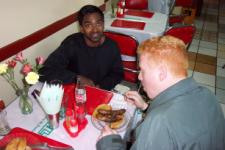
|
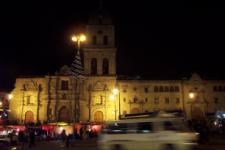
|
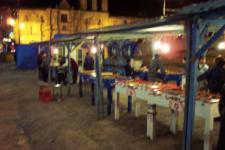
|
| Dinnertime | Iglesia de San Francisco | Foosball!! |
|
4-Jan-2003 - Got up at 6 AM, packed up, and headed out. Leaving our bags at the hotel, we set out on a day trip to the ruins of Tiahuanaco. Tiahuanaco (or Tiahuanacu or Tiwanaku) was the center of a pre-Columbian culture that held sway over much of the region from circa 600 BC to 1200 AD. Not much else is known about them.
To get there, we hopped aboard a collectivo. Collectivos are one of the more interesting public transportation experiences that I've had. Essentially take a Scooby-Doo style van, affix removable placards to the front to advertise the destination, and further advertise the destination by having a toll collector scream out where they are going to passers by, and pack everyone in like sardines. At the peak of the trip, there were fifteen other passengers, not counting our party, nor the driver, nor the "collector".
The trip through the countryside was neat. Physically, it doesn't look that much different from Nevada or parts of Texas. On the other hand, one does get a taste for the poverty that exists out here. Off of the main highway, unkempt dirt and gravel roads lead into run down hamlets, most of which probably without running water nor sewers, nor electricity.
One surreal part of the ride was when we passed through a toll booth, villagers hanging around next to the toll booth crowded around the collectivo selling soda and pasteries. A few people on the collectivo bought some. This experience was repeated on the return trip.
We got let off at Tiahuanaco. The site consisted of the ruins itself, a museum, the requisite visitor's center, and Puma Punku (Gateway of the Puma). The ruins were pretty neat, for the most part they were excavated relatively recently. One of the neater aspects about visiting these ruins is the marked difference between how tourist sites were handled here verses how they are in the developed world. The museum and the visitor's center for the most part did not look that different, if just less glitzy. But when walking around the ruins themselves, it was refreshingly free of handholding. No fenced off paths, no lighted walkways, nor anything else of the sort. My morbid personal favorite was the various stone carved heads in the temple, each of which supposedly represent a conquered tribe.
|
||||
| The museum at Tihuanaco |
|
|||||
|
|||||
|
|||||
| The ruins |
After about four hours (and after catching a minor sunburn in the beautiful weather that we been enjoying), we caught a collectivo for the ride back to La Paz. We got a bite to eat (got a taste for empanadas picantes), and set off for Copacabana.
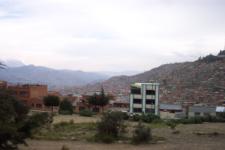
|
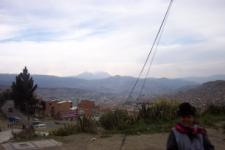
|
| On our way out of La Paz |
On the bus ride, a peculiar thing happened. The bus got to a ferry, and all of the passengers were unloaded. The bus was placed on a very precarious-looking ferry and the passengers were placed on another ferry. Corey described the same phenomenon on his bus trip to La Paz. It would later be realized that the reason was that if something happens, it is easier to rescue people on a ferry than if they were in a bus on a ferry.
We arrived in Copacabana at about 9 PM. We went to the hotel recommended by the people in La Paz... full. We went to another hotel recommended in our guidebook... also full. We soon came to the realization that despite the fact that this town seems to be crawling with hotels, they were all full. The odd thing is that when we asked if there was a festival or something along those lines going on, the answer was no - everything was full just for the weekend.
We started preparing for the possibility that we would have to go up to a hillside and camp out (which wouldn't have been terrible, because it was a warm night). Eventually, we got to a hotel called "Hotel 6 Agosto", and despite the fact that they were full, they offered to let us camp out in their rec room. Oddly, the subject of price never came up, but we did state an intention of staying there the next night. Now that we got things settled, we got dinner at the adjoining restaurant, and got some sleep.
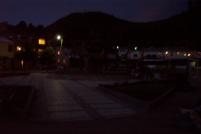
|
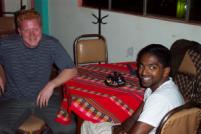
|
| Crossing the ferry | Finally @ Copacabana |